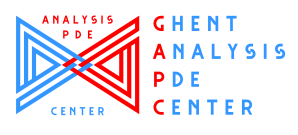
The influence of geometry on the analysis properties and the behavior of solutions of PDE is a fundamental and natural question in the study of mathematics. Riemannian symmetric spaces are the most exciting and essential manifolds in Remiannan geometry. These spaces were discovered and completely classified by Élie Cartan [Car26, Car27]. They furnish a rich and manageable class of manifolds that plays an important role in various branches of mathematics, like differential geometry, algebraic topology, number theory, harmonic analysis, etc.

Symmetric spaces can be described in different ways. Intuitively, a symmetric space is a manifold on which one extends the concept of central symmetry on geodesics. We can say it possesses a geodesic symmetry about each point. From the Lie theory’s point of view, a symmetric space is the quotient G/K of a connected Lie group G by a compact Lie subgroup K (the invariant group of an involution of G).
Harmonic analysis on symmetric spaces, sometimes called spherical Fourier analysis, has expanded rapidly since the 1950s. After Israel Gelfand and Harish-Chandra‘s pioneering works of spherical functions, the elementary analysis tools have been progressively perfected by their followers, such as Sigurður Helgason, Ramesh Gangolli, Veeravalli S. Varadarajan, etc. The spherical Fourier analysis connects several fundamental areas of mathematics such as number theory, representation theory, Fourier analysis, and PDE. It naturally becomes itself a central branch in contemporary mathematics.


From the 1980s, these analysis tools have been applied to the study of evolution equations to obtain optimal results and understand the influence of geometry on the behavior of solutions. We are interested in the symmetric spaces of non-compact type, which are manifolds with nonpositive sectional curvature and exponential growth at infinity. This particular geometry leads us to some different phenomenons than the Euclidean setting. Here, we list some references in this context.
- General references:
———- Last updates 26/01/2022 ———-

